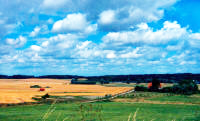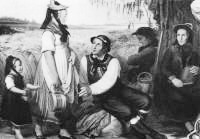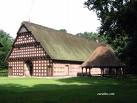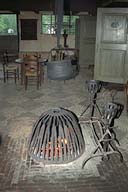|
 In the time of our German
ancestors, animals and people lived under one roof. This was
especially common in the years previous to the beginning of the
20th century, all across Germany but especially in the northern
sections. In the time of our German
ancestors, animals and people lived under one roof. This was
especially common in the years previous to the beginning of the
20th century, all across Germany but especially in the northern
sections.
This is what the typical farmer's life was like. Keep in mind as
you read this that nearly everyone in the days previous to the
early years of the 1900s were classified as "farmers" as we
would think of the term. Few people were businessmen or
landowners.
 In the villages and across the countryside stood these large
barn-like structures which served many purposes. Usually, the
farmer entered through the front of this long structure with his
horses and cattle, through a large door that usually had a
smaller door cut into it, so that in cooler weather, he could
keep the large double doors closed and family members could just
use the smaller cut out door to come and go. In the villages and across the countryside stood these large
barn-like structures which served many purposes. Usually, the
farmer entered through the front of this long structure with his
horses and cattle, through a large door that usually had a
smaller door cut into it, so that in cooler weather, he could
keep the large double doors closed and family members could just
use the smaller cut out door to come and go.
Animals were kept in the large front part of the barn and there
was no separation between animals and the family members.
Separation between livestock and people only came in the very
late 1800s or the early 1900s. In the former times, the cattle,
horses, pigs, chickens and whatever else the farmer used to
support his family slept in the same space as the family members
who tended them and depended on them for their food and support.
Here's what a typical farmhouse and barn would be like:
 The farmer comes through the large double doors of the barn
leading his team of oxen. Only the rich could afford draft
horses to pull their plow. Thick smoke billows out of the doors
as he enters from a hard day spent in the fields. Is the house
on fire? No, it's just the open fire that is kept burning day
and night in the center of the living quarters at the back of
the house. This large open fire sends smoke throughout the
house. Smoke is a good thing. It cleanses the air of bacteria.
It also dries the crops, which are stored in the loft high in
the rafters of the house. The smoke cures meat, hanging from
hooks above the living area. The smoke drives away insects. The farmer comes through the large double doors of the barn
leading his team of oxen. Only the rich could afford draft
horses to pull their plow. Thick smoke billows out of the doors
as he enters from a hard day spent in the fields. Is the house
on fire? No, it's just the open fire that is kept burning day
and night in the center of the living quarters at the back of
the house. This large open fire sends smoke throughout the
house. Smoke is a good thing. It cleanses the air of bacteria.
It also dries the crops, which are stored in the loft high in
the rafters of the house. The smoke cures meat, hanging from
hooks above the living area. The smoke drives away insects.
 But the smoke also causes health problems and a sort of "black
lung" disease that kills people long before the end of their
normal lifespan. That's why in the 1800s and before, people
normally slept sitting up. This helped to keep their lungs clear
of the soot and grime that accumulates there during the day.
We've all seen the little beds that people slept in during those
days, and the usual explanation is that "people were smaller in
those days." That's not true. The beds are shorter because if
you are sleeping sitting up, you only need slightly more than
half the length of bed that you'd need if you were laying flat
on your back. But the smoke also causes health problems and a sort of "black
lung" disease that kills people long before the end of their
normal lifespan. That's why in the 1800s and before, people
normally slept sitting up. This helped to keep their lungs clear
of the soot and grime that accumulates there during the day.
We've all seen the little beds that people slept in during those
days, and the usual explanation is that "people were smaller in
those days." That's not true. The beds are shorter because if
you are sleeping sitting up, you only need slightly more than
half the length of bed that you'd need if you were laying flat
on your back.
In all seasons, winter or summer, the fire was kept burning and
there
was no chimney, nor was there any kind of "hood" over the
flames. Imagine the house from the exterior, smoke billowing out
every open window and door. Imagine the problems that this
created with barns that had grass roofs, a common feature
throughout Germany up into the 1900s. Families hoped for a cool,
damp day because during these days, the smoke and sparks
were usually minimized.
|